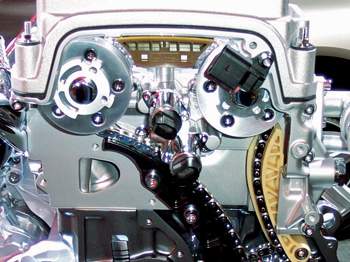Magnum Gaskets Expands Product Line with New Head Gaskets and Head Sets
Magnum Gaskets, an MSI brand, has announced plans for a major product line expansion in the fourth quarter of 2012, which the company says will more than double the gasket sales potential for Magnum’s aftermarket distribution partners.
Tech Tip: Dodge Ram Transmission Weakpoint Leads to Converter Update
The main reason this occurs is that the piston is not properly centered on the turbine hub of the converter.
Timing Belt Replacement on Jeep’s 2.4L PowerTech Engine
In its short life, the engine was available in the 2002-’06 Jeep Liberty (first generation), as well as the 2004-’06 Jeep Wrangler, but was discontinued when Jeep introduced the Compass and Patriot small crossovers.
Subaru Outback Head Gasket Repair
The Subaru is a 2002 Outback with 109,982 miles. It has excessive oil leaks from the driver’s side head gasket and some from the passenger’s side. The vehicle had been repaired under warranty by the dealer at about 65,000 miles, and most likely the repairs were done without taking the engine out with probably only one head gasket being replaced. To complete the repair, follow the steps outlined in this article.
The Ins and Outs of Variable Valve Timing (VVT) Systems and Their Role in Vehicle Emissions
By the early 1990s, almost all import automotive manufacturers had a successful variable valve timing (VVT) system in production. These systems offered higher performance from smaller displacement engines at higher rpm. Do you know that VVT is playing a direct role in vehicle emissions and the way gases are burned in the combustion chamber?

King Engine Bearings Launches Facebook Page
King Engine Bearings, a leader in automotive, aviation and high-performance engine bearings, has launched an official Facebook page for business customers and consumers. The company is encouraging people to “like” the page in order to receive the latest updates on King products, events, technical data and industry news.
Book Report: Tips for Ford Power Stroke Service and Rebuilds
The book covers the vast majority of Power Stroke diesel engines on the road, and gives you the full story on their design.
Tech Talk – Engine Innovations to Reach Government Fuel Standards
In recent years, the primary driving force behind engine innovation has been the never-ending quest for better fuel economy with little or no sacrifice in performance. Government regulations and rising fuel prices are forcing automakers to develop new technologies and powertrains that squeeze more power out of every drop of fuel while producing less pollution and greenhouse gas (carbon dioxide) emissions.
Diagnosing Murphy’s Law Under the Hood of a Ford F-150
Most of us working in the automotive service trades are very familiar with Murphy’s Law and how it affects our shop’s cost of doing business. Murphy’s Law says, “Everything that can go wrong usually will go wrong.” Gary Goms investigates a mysterious engine noise in a 1989 Ford F-150 pickup equipped with the venerable 5.0L or 302 cubic-inch V8 engine.
A 360° Look Into the GM 60° 3.1L Engine
Over the years, GM has saved a bundle on manufacturing the 3.1L engine by using the production line tooling it originally developed for the 2.8L V6. By simply changing the bore diameter, the displacement of the same engine block could now be increased for more power and torque.
Getting Stoked to Service the 6.0L Power Stroke
If there were one engine that plagues the mid-size diesel world, you would have to say that it is the 6.0L Power Stroke. The 6.0L came into existence because the EPA demanded tighter emissions laws for diesel engines. Even though the 7.3L was branded as the reliable workhorse for Ford, it would never be able to pass the tighter emissions laws that were going to come into effect for 2004.
Tech Feature: Troubleshooting Internal Errors – Solving Piston and Ring Breakdowns
Rings that do not seal well during all four phases of the four-cycle combustion process can reduce an engine’s power potential by 20, 30, 40 or more horsepower, depending on the engine’s displacement, compression ratio and speed. Rings that leak during the intake stroke will reduce air velocity and volumetric efficiency.
